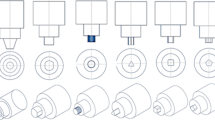Abstract
AA6061 aluminium alloy (Al-Mg-Si alloy) has gathered wide acceptance in the fabrication of light weight structures requiring a high strength-to-weight ratio and good corrosion resistance. Compared to the fusion welding processes that are routinely used for joining structural aluminium alloys, the friction stir welding (FSW) process is an emerging solid state joining process in which the material that is being welded does not melt and recast. This process uses a non-consumable tool to generate frictional heat in the abutting surfaces. The welding parameters such as tool rotational speed, welding speed, axial force etc., and the tool pin profile plays a major role in deciding the weld quality. In this investigation an attempt has been made to understand the effect of axial force and tool pin profiles on FSP zone formation in AA6061 aluminium alloy. Five different tool pin profiles (straight cylindrical, tapered cylindrical, threaded cylindrical, triangular and square) have been used to fabricate the joints at three different axial force levels. The formation of FSP zone has been analysed macroscopically. Tensile properties of the joints have been evaluated and correlated with the FSP zone formation. From this investigation it is found that the square tool pin profile produces mechanically sound and metallurgically defect free welds compared to other tool pin profiles.
Similar content being viewed by others
References
Madhusudhan Reddy GM, Sammaiah P, Murthy CVS, Mohandas T (2002) Influence of welding techniques on microstructure and mechanical properties of AA 6061 (Al-Mg-Si) gas tungsten arc welds, Proc. of National Conference on Processing of Metals. Coimbatore 33–46
Kou S, Le Y (1986) Nucleation mechanism and grain refining of weld metal. Weld J 65–70
Prasad RK, Reddy GM, Gokhale AA (1999) Grain refinement and improvement of strength and ductility of welds by pulsed current and magnetic arc oscillation techniques. International Welding Conference, New Delhi, pp. 1050–1055
Dawes CJ (1995) An introduction to friction stir welding and its development. Weld Metal Fabr pp 12
Thomas WM et al (1991) Friction stir welding, International Patent Application No. PCT/GB92/02203 and GB Patent Application No. 9125978.8, December 1991, U.S Patent No. 5,460,317
Rhodes CG, Mahoney MW, Bingel WH, Spurling RA, Bampton CC (1997) Scr Mater 36:69
Murr LE, Flores RD, Flores OV, McClure JC, Liu G, Brown D (1998) Mater Res Innov 1:211
Lomolino S, Tovo R, Dos Santos J (2005) On the fatigue behavior and design curves of friction stir butt welded Al alloys. Int J Fatigue 27:305–316
Buffa G, Hua J, Shivpuri R, Fratini L (2006) A continuum based FEM model for friction stir welding - model development. Mater Sci Eng A 419:389–396
Dawes CJ, Thomas WM (1996) Weld J 75:41
Oosterkamp A, Djapic Oosterkamp L, Nordeide A (2004) Kissing bond phenomena in solid state welds of Aluminum alloys. Weld J:225s–231s
Zeng WM, Wu HL, Zhang J (2006) Effect of tool wear on microstructure, mechanical properties and acoustic emission of friction stir welded 6061 Al alloy. Acta Metall Sin 19(1):9–19
Thomas WM, Nicholas ED (1997) Friction stir welding for the transportation industries. Mater Des 18:269–273
Thomas WM, Dolby RE (2002) Friction Stir Welding Developments. Proceedings of 6th International Trends in Welding Research Conference, pp 203–211.
Ouyang JH, Jandric D, Kovacevic R, Song M, Valant M (2002) Visualization of Material Flow during Friction Stir Welding (FSW) of the same and Dissimilar Aluminum Alloys. Proceedings of 6th International Trends in Welding Research, pp 229–240
Krishnan KN (2002) On the formation of onion rings in friction stir welds. Mater Sci Eng A 327:246–251
Author information
Authors and Affiliations
Corresponding author
Rights and permissions
About this article
Cite this article
Elangovan, K., Balasubramanian, V. & Valliappan, M. Influences of tool pin profile and axial force on the formation of friction stir processing zone in AA6061 aluminium alloy. Int J Adv Manuf Technol 38, 285–295 (2008). https://doi.org/10.1007/s00170-007-1100-2
Received:
Accepted:
Published:
Issue Date:
DOI: https://doi.org/10.1007/s00170-007-1100-2




